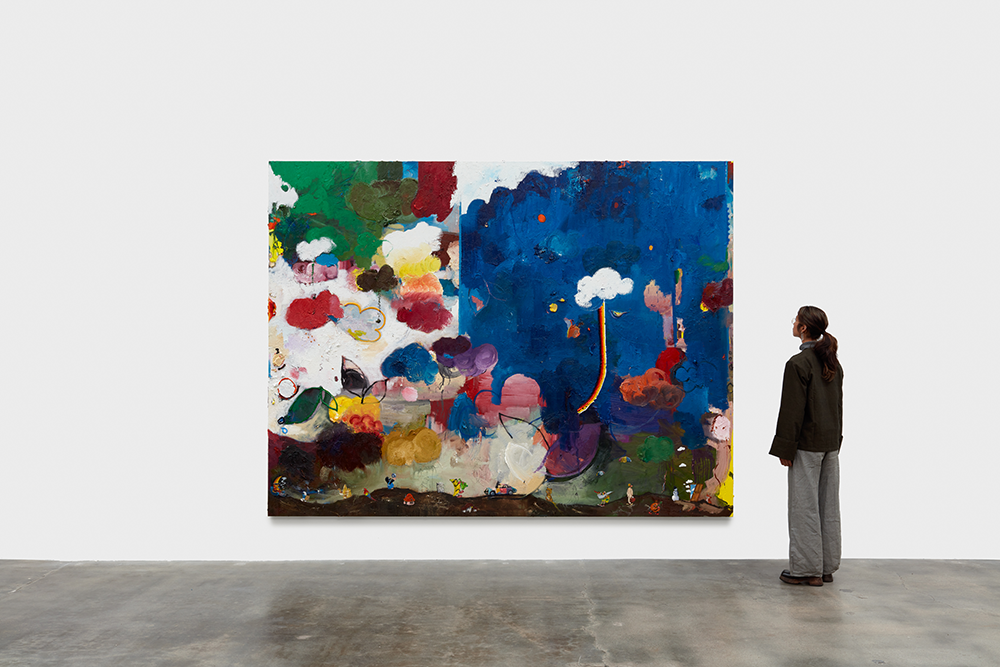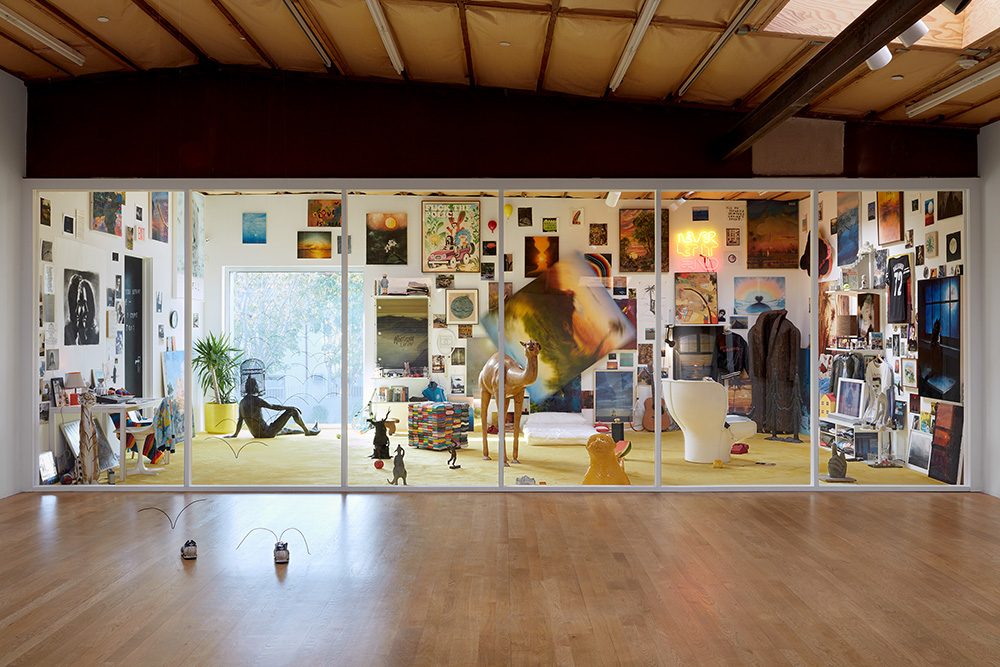It is not unusual for an exhibition of Friedrich Kunath’s paintings to be accompanied by something outrageous and unexpected. In both 2012 and 2017 he carpeted gallery floors, transforming them into soft, colorful fields dotted with sculptures, couches, socks, giant shoes and other incongruous objects. His latest exhibition “I Don’t Know The Place, But I Know How To Get There,” fills both floors of Blum & Poe. In the upper gallery, nested against the back window, is a glassed-in faux storefront where Kunath has installed pieces from previous exhibitions, including older paintings and sculptures, musical instruments, books, tennis rackets and balls, written notes and furniture. This quasi-studio/living space is presented as a sealed off display. It begs for close-up scrutiny, as it serves as the key to the exhibition by providing context to many of the other works, yet no access is permitted.
Kunath’s large-scale oils often take their point of departure from 18th and 19th century Romantic landscape paintings, but rather than explore man’s blissful relationship with nature and the sublime, the works are sardonic investigations filled with irony and wit. Many of Kunath’s titles are reminiscent of melancholic song lyrics, and in the upstairs installation there are numerous albums, as well as references, to the pop singer/songwriter Morrissey. In paintings with titles such as Looking Back, I Should’ve Been Home More; I Should’ve Left A Long Time Ago; In Memory Of My Memories; I Think I’m Going To Stay For A While; Return To Forever and Coming Home Was As Beautiful As Going Away (2022-23), he juxtaposes realistic depictions of mountains, seascapes, rivers, sunsets, rainbows and billowing clouds (some in the shape of guitars) with cartoon characters, snippets of text from song lyrics scratched into the wet paint and other references to popular culture, to create a visual and emotional disconnect that unleashes a sense of unease and dislocation.

Friedrich Kunath, I Know I Need A Small Vacation, 2022. Courtesy of Blum & Poe. Image: Evan Walsh.
This is most evident in Coming Home Was As Beautiful As Going Away (2022) which, at first glance, appears to be a large mountain peak surrounded by pink and orange hues as it juts up into the sky above the clouds. Upon closer examination, the triangular shaped foreground is transformed into the wing of a large airplane flying through the sky. Handwritten black words spelling out the paintings title follow the contour of the side of the wing and float off the edge, disappearing into the sky. Return To Forever (2022-2023) is a huge horizontal painting spanning 12 feet. In it, a rainbow arches across the top portion of the painting above a lush green field bisected by a narrow receding road. A line of crops parallels the horizon, and when it crosses the road it becomes a tennis net, somehow evoking awe, confusion and humor.
Hastily scrawled words and phrases are often embedded into Kunaths’s paint surfaces, either suspended in the sky or etched into less impastoed areas. It is not unusual for him to combine carefully rendered sections or swaths of thick color that bulge from the surface with flatly painted cartoon characters who appear both at home and out of place in his landscapes. Cars, as well as bits of imagery culled from advertisements and popular culture, often disrupt beautiful and majestic settings, prompting viewers to puzzle out why. Kunath’s juxtapositions are as interesting as they are surprising, and inject a new narrative direction into traditional landscape painting that otherwise might be construed as banal or obvious.


